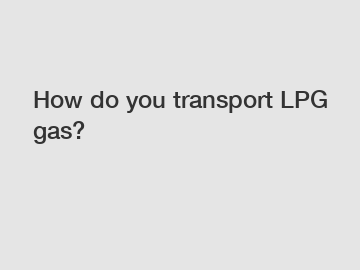Feb. 19, 2024
Transportation
Transporting LPG gas is a crucial and complex process that requires careful planning, strict safety measures, and adherence to regulations. LPG, or liquefied petroleum gas, is a versatile and efficient fuel commonly used for heating, cooking, and powering vehicles.
There are several methods for transporting LPG gas, each with its own set of advantages and challenges. The most common methods include pipelines, tankers, and cylinders, each serving a specific purpose based on the distance of transportation and the volume of gas being transported.
Pipelines are the most efficient and cost-effective way to transport LPG gas over long distances. These underground pipes are designed to carry large volumes of gas from production facilities to distribution centers or storage tanks. While pipelines are great for transporting large quantities of gas, they require extensive infrastructure and are limited to specific routes.

Tanker trucks, also known as bobtails, are another common method for transporting LPG gas. These specialized vehicles are equipped with pressurized tanks that can safely transport gas from refineries or storage facilities to residential or commercial locations. Tanker trucks are versatile and can access remote locations that are not connected to pipelines, making them a valuable asset in the distribution chain.
Cylinders are the most common method for transporting LPG gas on a small scale. These portable containers are typically used for residential applications, such as heating and cooking, and can be easily transported in vehicles. Cylinders are convenient for transporting small quantities of gas and are often used in areas where pipelines are not available.
Regardless of the method used, safety is of utmost importance when transporting LPG gas. LPG is a highly flammable and explosive gas that requires proper handling and storage to prevent accidents. To ensure the safe transportation of LPG gas, strict safety regulations and guidelines are followed by all parties involved in the process.
Proper training and education are essential for anyone involved in the transportation of LPG gas. Drivers of tanker trucks must be trained in handling hazardous materials and follow strict protocols to prevent leaks or accidents. Additionally, all equipment used for transporting LPG gas must be regularly inspected and maintained to ensure safe operation.
Environmental considerations are also important when transporting LPG gas. While LPG is a cleaner-burning fuel compared to traditional fossil fuels, leaks or spills during transportation can have negative environmental impacts. Proper handling and storage of LPG gas are crucial to prevent pollution and reduce greenhouse gas emissions.
In conclusion, transporting LPG gas is a critical process that requires careful planning, strict safety measures, and adherence to regulations. Whether through pipelines, tankers, or cylinders, the safe transportation of LPG gas is essential to ensure the efficient and reliable supply of this versatile fuel. By following best practices and implementing proper safety measures, we can continue to enjoy the benefits of LPG gas while minimizing environmental impact and ensuring public safety.
For more industrial Gas Transportation Equipment supplier, LNG Storage Tank manufacturer, industrial Gas Storage Equipmentinformation, please contact us. We will provide professional answers.
If you are interested in sending in a Guest Blogger Submission,welcome to write for us!
All Comments ( 0 )